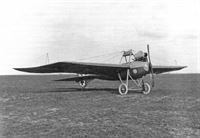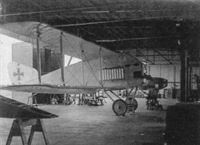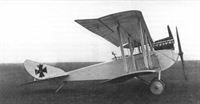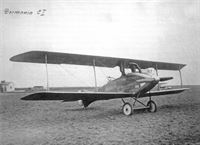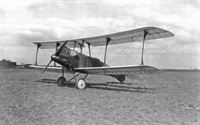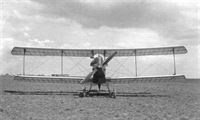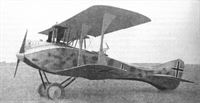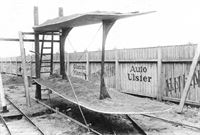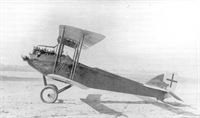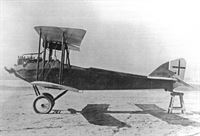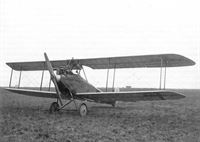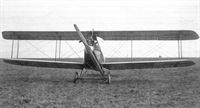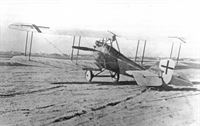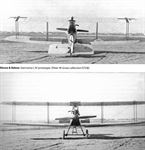Книги
Centennial Perspective
M.Dusing
Germania Flugzeugwerke and Its Aircraft
121
M.Dusing - Germania Flugzeugwerke and Its Aircraft /Centennial Perspective/ (41)
Germania Flight School, training aircraft. From left to right: Albatros B I (Germ.), Rumpler C.I."13" (Germ.), Albatros B II (Germ., 1915). The photo was not taken before April 1918, because only at this time, as can be seen in the picture, Balkenkreuz replaced the "Iron Crosses".
Aircraft wrecks delivered for repair: Rumpler C.IV 8474/16, Rumpler C.I 6519/16, Rumpler C.IV 8280/16, and Albatros C.VII 1295/16.
Germania Taube (Observation Aircraft/Trainer)
Despite innovative elements, such as the wooden band tube technology, Egwin Leiber's early designs did not have any significant success. Neither the already mentioned Taube with a 50 hp four-cylinder Argus engine (1912) nor the other Tauben (doves) with a 100 hp six-cylinder Argus engine, a few of which were still delivered to the army or navy in 1914/1915, resulted in a viable series production. All Taube fanciers used tape tube technology, with the wings having the traditional Zanonia shape.
The exact number of Germania A.I Tauben delivered is not known. S 18 was a naval landplane that was likely a Germania A.I (noted as a Rahtjen).
Germania A.I Taube Specifications
Engine: 100 hp Argus
Wing: Span 14.0 m
General: Length 10.2 m
Height 3.2 m
Wing Area 30 m1
Empty weight 690 kg
Max Take-off weight 1062 kg
Max. Speed 96 km/h
Max. Operating Range 385 km
Despite innovative elements, such as the wooden band tube technology, Egwin Leiber's early designs did not have any significant success. Neither the already mentioned Taube with a 50 hp four-cylinder Argus engine (1912) nor the other Tauben (doves) with a 100 hp six-cylinder Argus engine, a few of which were still delivered to the army or navy in 1914/1915, resulted in a viable series production. All Taube fanciers used tape tube technology, with the wings having the traditional Zanonia shape.
The exact number of Germania A.I Tauben delivered is not known. S 18 was a naval landplane that was likely a Germania A.I (noted as a Rahtjen).
Germania A.I Taube Specifications
Engine: 100 hp Argus
Wing: Span 14.0 m
General: Length 10.2 m
Height 3.2 m
Wing Area 30 m1
Empty weight 690 kg
Max Take-off weight 1062 kg
Max. Speed 96 km/h
Max. Operating Range 385 km
Germania Taube (1914) with 6 cylinder Argus engine and Wolff propeller.
Military Germania-Taube with "Eisernem Kreuz" (Iron Cross). A pilot and observer comprised the crew.
Military Germania-Taube with "Eisernem Kreuz" (Iron Cross). A pilot and observer comprised the crew.
Fhe first Germania-Tauben, production line in Leipzig-Mockau. In front and in the back are Lawrenz-Tauben in production (100 hp 4-cyl. Argus).
Final assembly of Germania-Taube. In front is a Lawrenz-Tauben (100 hp 4-cyl. Argus).
Six-cylinder Argus As.I and Wolff propellers have been used.
Six-cylinder Argus As.I and Wolff propellers have been used.
B.I Biplane (Trainer)
This training aircraft from 1914/15 is a two-bay, two-seat biplane with a plywood fuselage. This two-seater was equipped with a 120 hp Argus As II.
Several Germania B.I aircraft were built, but neither the exact number nor the military units to which they were assigned are known. Matching statements prove that above all the Imperial Navy airmen were supplied. These were exclusively land planes. In the German Military Number Index are listed the designations: B.1050-1051/14 "Rahtjen B". These two aircraft finally went to the Navy, where they received the designations S.136 and S.137 (even before the changeover to the new L-number system). For sure these unarmed 2-seaters were used by the Freiwilligen Marinecorps (Volunteer Marinecorps) in Johannisthal or on its training field, the Bornstedter Feld near Potsdam.(1) The Imperial Navy only had this one central land flying training squadron at that time. Other land aviation units, especially the defense squadrons for the defense of naval bases and airship bases, but also other flight training squadrons, were not established until 1916.
Perhaps early in 1916, the company launched an improved version of the aircraft designated KDD (Kampf-Doppeldecker). This reconnaissance aircraft differed from the B.I. by its wing design, a more powerful 150 hp Benz Bz III engine and a Parabellum 7.92 mm machine gun mounted on a movable turret in the rear cockpit.
(1) It is possible that the two Rahtjen aircraft did not receive their military numbers until then. They belonged to the last military numbers of 1914, which could possibly be related to the fiscal year of the military (01.04. to 31.03. of the following year). Possibly these were also the first Germania biplanes (type B.I), which were taken over/commissioned at the beginning of 1915 under the name Rahtjen, which can be explained by the fact that the formal renaming from Rahtjen to Germania was only carried out at the end of 1915.
This training aircraft from 1914/15 is a two-bay, two-seat biplane with a plywood fuselage. This two-seater was equipped with a 120 hp Argus As II.
Several Germania B.I aircraft were built, but neither the exact number nor the military units to which they were assigned are known. Matching statements prove that above all the Imperial Navy airmen were supplied. These were exclusively land planes. In the German Military Number Index are listed the designations: B.1050-1051/14 "Rahtjen B". These two aircraft finally went to the Navy, where they received the designations S.136 and S.137 (even before the changeover to the new L-number system). For sure these unarmed 2-seaters were used by the Freiwilligen Marinecorps (Volunteer Marinecorps) in Johannisthal or on its training field, the Bornstedter Feld near Potsdam.(1) The Imperial Navy only had this one central land flying training squadron at that time. Other land aviation units, especially the defense squadrons for the defense of naval bases and airship bases, but also other flight training squadrons, were not established until 1916.
Perhaps early in 1916, the company launched an improved version of the aircraft designated KDD (Kampf-Doppeldecker). This reconnaissance aircraft differed from the B.I. by its wing design, a more powerful 150 hp Benz Bz III engine and a Parabellum 7.92 mm machine gun mounted on a movable turret in the rear cockpit.
(1) It is possible that the two Rahtjen aircraft did not receive their military numbers until then. They belonged to the last military numbers of 1914, which could possibly be related to the fiscal year of the military (01.04. to 31.03. of the following year). Possibly these were also the first Germania biplanes (type B.I), which were taken over/commissioned at the beginning of 1915 under the name Rahtjen, which can be explained by the fact that the formal renaming from Rahtjen to Germania was only carried out at the end of 1915.
Germania B.I. The national insignia were painted on white backgrounds on both top and bottom of the wings. Each cylinder has a short exhaust pipe. (Peter M Grosz collection/STDB)
Germania B.I N.D.D. with long exhaust as a postcard. N.D.D. may have stood for "Normal Doppel-Decker", or normal biplane. (Peter M Grosz collection/STDB)
Germania B I with 6 cylinder Argus engine and Wolff propeller. This aircraft has a long, over the wing exhaust.
Germania B.I. The national insignia were painted on white backgrounds on both top and bottom of the wings. An unknown but small number of Germania B.I trainers were built, primarily for the Germania Flight School. Two were assigned to the Navy as LF 197 and 198. (Peter M Grosz collection/STDB)
Germania B.I with another style of exhaust using a single collector. (Peter M Grosz collection/STDB)
Germania B.I LF.198 was a land-based naval trainer. LF.197 was the one other Germania B.I in naval service.
This Germania B.I has an enlarged fin. The writing "1. Flug." on the photo indicates one aircraft, which may mean one aircraft was so modified. This modification may have been a transition to the more powerful KDD type that needed a larger fin and rudder for directional control. The KDD fin and rudder were larger than the one on this aircraft due to the more powerful 150 hp Benz Bz.III used in the KDD. (Peter M Grosz collection/STDB)
Germania production hall after 9 months (1915); in front different B-types. Fliegerschule means flying school.
Germania DB Two-Seat Fighter
The "DB", a larger two-seat version of the JM fighter was developed in parallel with the JM. It was designed as a two-seater fighter, with a 180 hp Argus As III engine. The observer/gunner had a free field of fire in front over the propeller arc. As with the other Germania-designed aircraft, only one DM prototype was built and tested in 1915.
The DB two-seat fighter utilized the efficient Walfisch (Whale) fuselage configuration of the JM model which endowed the gunner, who sat ahead of the pilot, with a broad forward field of fire. A two-bay biplane, the DB was powered by a water-cooled engine, carried a single flexible machine gun on a ring mounting in the forward cockpit, and underwent trials in September 1915.
The DB underwent an intensive technical investigation through the Royal Marine Marine-Landflugzevg-Abnahme-Kommission (Marine Landplane Inspection Commission) situated in Berlin-Johannisthal.
Although the general recommendation of the investigation team supported the introduction of this unique type, a production order was never signed. Egwin Leiber felt that the effort required to implement all the required technical changes was too enormous. Therefore, Germania Flugzeugwerke decided to stop any further development of this type.
Germania DB Specifications
Engine: 180 hp Argus As.III
Wing: Span 8.78 m
General: Weight, Empty 720 kg
Armament: one 7.9 mm machine gun
The "DB", a larger two-seat version of the JM fighter was developed in parallel with the JM. It was designed as a two-seater fighter, with a 180 hp Argus As III engine. The observer/gunner had a free field of fire in front over the propeller arc. As with the other Germania-designed aircraft, only one DM prototype was built and tested in 1915.
The DB two-seat fighter utilized the efficient Walfisch (Whale) fuselage configuration of the JM model which endowed the gunner, who sat ahead of the pilot, with a broad forward field of fire. A two-bay biplane, the DB was powered by a water-cooled engine, carried a single flexible machine gun on a ring mounting in the forward cockpit, and underwent trials in September 1915.
The DB underwent an intensive technical investigation through the Royal Marine Marine-Landflugzevg-Abnahme-Kommission (Marine Landplane Inspection Commission) situated in Berlin-Johannisthal.
Although the general recommendation of the investigation team supported the introduction of this unique type, a production order was never signed. Egwin Leiber felt that the effort required to implement all the required technical changes was too enormous. Therefore, Germania Flugzeugwerke decided to stop any further development of this type.
Germania DB Specifications
Engine: 180 hp Argus As.III
Wing: Span 8.78 m
General: Weight, Empty 720 kg
Armament: one 7.9 mm machine gun
The Germania DB two-seater fighter prototype of 1915 carried a gunner ahead of the pilot, firing above the upper wing.
The Germania DB was similar in concept to the AEG C.III. Designed as a two-seat fighter, the gunner sat in the front cockpit and was armed with a flexible and unsynchronized machine gun, with the propeller obscuring the field of fire forward and downward.There was no synchronized gun for the pilot. The DB also featured a fish-shaped fuselage profile with rectangular cross section for streamlining, but had external radiators. It was a 2-bay design that remained a prototype.
The Germania DB was similar in concept to the AEG C.III. Designed as a two-seat fighter, the gunner sat in the front cockpit and was armed with a flexible and unsynchronized machine gun, with the propeller obscuring the field of fire forward and downward.There was no synchronized gun for the pilot. The DB also featured a fish-shaped fuselage profile with rectangular cross section for streamlining, but had external radiators. It was a 2-bay design that remained a prototype.
Germania KDD Combat Biplane
The KDD (Kampfdoppeldecker = combat biplane) was designed in 1916 as an armed C-type aeroplane. The aircraft was powered by a 150 hp Benz Bz III engine. The basic construction of this aircraft equipped with a wooden fuselage did not differ from the previous models.
It is not known that this aircraft was ever presented to the Heeresverwaltung. Only the prototype was built and tested in flight.
The KDD (Kampfdoppeldecker = combat biplane) was designed in 1916 as an armed C-type aeroplane. The aircraft was powered by a 150 hp Benz Bz III engine. The basic construction of this aircraft equipped with a wooden fuselage did not differ from the previous models.
It is not known that this aircraft was ever presented to the Heeresverwaltung. Only the prototype was built and tested in flight.
Germania KDD prototype was a C-type reconnaissance airplane. Iron cross national insignia were applied.
Germania JM Fighter
The Germania JM (Jagdmaschine = pursuit machine) experimental single-seat fighter was based on the promising results of wind tunnel testing with the Walfisch (Whale) fuselage configuration at Gottingen. Designed by J Egwin Leiber, the JM was a single-bay biplane powered by a 100 hp Argus As.I water-cooled engine and made its debut in the summer of 1916. While under test on 16 August 1916, the JM attained altitudes of 3,280 ft (1,000 m) in 4 min, 6,560 ft (2,000 m) in 11 min, 9,845 ft (3,000 m) in 19 min and 10,825 ft (3,300 m) in 20 min. No further development was undertaken, and no data are available.
Germania JM Specifications
Engine: 100 hp Argus As.I
Wing: Span 7.62 m
General: Length 5.28 m
Height 2.02 m
Weight, Empty 568 kg
Climb: 1,000 m 4 min
2,000 m 11 min
3,000 m 19 min
3,300 m 20 min
The Germania JM (Jagdmaschine = pursuit machine) experimental single-seat fighter was based on the promising results of wind tunnel testing with the Walfisch (Whale) fuselage configuration at Gottingen. Designed by J Egwin Leiber, the JM was a single-bay biplane powered by a 100 hp Argus As.I water-cooled engine and made its debut in the summer of 1916. While under test on 16 August 1916, the JM attained altitudes of 3,280 ft (1,000 m) in 4 min, 6,560 ft (2,000 m) in 11 min, 9,845 ft (3,000 m) in 19 min and 10,825 ft (3,300 m) in 20 min. No further development was undertaken, and no data are available.
Germania JM Specifications
Engine: 100 hp Argus As.I
Wing: Span 7.62 m
General: Length 5.28 m
Height 2.02 m
Weight, Empty 568 kg
Climb: 1,000 m 4 min
2,000 m 11 min
3,000 m 19 min
3,300 m 20 min
The Germania JM fighter was powered by a 100 hp Argus As.I engine.
The Walfisch (whale) fuselage of the Germania JM failed to gain official acceptance for the fighter.
The Walfisch (whale) fuselage of the Germania JM failed to gain official acceptance for the fighter.
Germania JM prototype prepared for take off. Although the JM used the streamlined Walfisch shape in profile, it retained a rectangular fuselage cross-section. The production Roland C.II not only used the Walfisch profile, it used a more streamlined oval fuselage cross-section for reduced drag. Its increased speed was a major factor in its success.
Germania C.I Armed Reconnaissance Aircraft
Egwin Leiber tried to become known with his own aircraft developments, but met with little success.
The Germania-C airplanes were also among his own developments. These were two-seater armed reconnaissance aircraft, which could also be used in air combat or even for firing at ground targets.
The versions of the Germania C-types were combat two-seaters in the usual biplane design with two I-struts, engine completely covered, wooden construction, but with different radiator arrangements. The armament of the aircraft consisted of one front fixed machine gun LMG 08/15 Spandau and one 7.92 mm Parabellum machine gun mounted on a movable turret in the rear cockpit.
Leiber used the just developed 260 hp Maybach Mb.IVa engine, the first real German high-altitude aero-engine. This engine solved the problem of "thin" air, i.e. the low air pressure at higher altitudes, with three different carburetor settings: "La" (engine start), "V" (full throttle, flight up to 1800 m altitude) and "H" (altitude gas, from 1800 m). This piston engine was actually developed for use in airships. Leiber was probably not happy with this engine, because it seems that the cooling of this heavy engine could not be guaranteed sufficiently. The only Germania C.I aircraft that was produced was rebuilt several times and was called Version A, B, and C in the following.
Germ C.I (Version A)
This aeroplane was designed as a biplane with a unique 2-strut center section radiator mounted on the center section struts. This aircraft was rebuilt to the "Version B".
Germ C.I (Version B)
This aeroplane is very similar to the version A. The only visible differences are a 4-strut center section and ear radiators to cool the Maybach 260 PS MB.IVa engine.
Germ C.I (Version C)
Egwin Leiber modified the only existing aeroplane a second time and installed a airfoil radiator located on the upper wing center section, which might have required the need for the N-strut center section.
This aircraft underwent type testing in Berlin-Adlershof between 2 and 6 July 1918. Unfortunately, the results of the tests are not known, but it can be assumed that the performance was not satisfactory, as this was the only Germania C.I aircraft.
Egwin Leiber tried to become known with his own aircraft developments, but met with little success.
The Germania-C airplanes were also among his own developments. These were two-seater armed reconnaissance aircraft, which could also be used in air combat or even for firing at ground targets.
The versions of the Germania C-types were combat two-seaters in the usual biplane design with two I-struts, engine completely covered, wooden construction, but with different radiator arrangements. The armament of the aircraft consisted of one front fixed machine gun LMG 08/15 Spandau and one 7.92 mm Parabellum machine gun mounted on a movable turret in the rear cockpit.
Leiber used the just developed 260 hp Maybach Mb.IVa engine, the first real German high-altitude aero-engine. This engine solved the problem of "thin" air, i.e. the low air pressure at higher altitudes, with three different carburetor settings: "La" (engine start), "V" (full throttle, flight up to 1800 m altitude) and "H" (altitude gas, from 1800 m). This piston engine was actually developed for use in airships. Leiber was probably not happy with this engine, because it seems that the cooling of this heavy engine could not be guaranteed sufficiently. The only Germania C.I aircraft that was produced was rebuilt several times and was called Version A, B, and C in the following.
Germ C.I (Version A)
This aeroplane was designed as a biplane with a unique 2-strut center section radiator mounted on the center section struts. This aircraft was rebuilt to the "Version B".
Germ C.I (Version B)
This aeroplane is very similar to the version A. The only visible differences are a 4-strut center section and ear radiators to cool the Maybach 260 PS MB.IVa engine.
Germ C.I (Version C)
Egwin Leiber modified the only existing aeroplane a second time and installed a airfoil radiator located on the upper wing center section, which might have required the need for the N-strut center section.
This aircraft underwent type testing in Berlin-Adlershof between 2 and 6 July 1918. Unfortunately, the results of the tests are not known, but it can be assumed that the performance was not satisfactory, as this was the only Germania C.I aircraft.
Germania C.I version A prototype. The high-mounted upper wing and large wing gap are noteworthy.
The Germania C.I also had a Maybach Mb.IVa.
The Germania C.I also had a Maybach Mb.IVa.
Germania C.I prototype version A with radiators on the center section struts. (Peter M Grosz collection/STDB)
Germania C.II Armed Reconnaissance Aircraft
The Germania C.II was also designed as a reconnaissance/combat two-seater with the 260 hp Maybach MB.IVa engine. It was an improved C.I with lowered upper wing and an airfoil cooler (see Germania C.I, Version C). The single prototype was built in 1917.
Germania C.III Armed Reconnaissance Aircraft
An enlarged version of the Germania C.II with a more conventional tail unit was the Germania C.III. The C.III was virtually identical to the C.II except for the different tail that featured balanced elevators and a balanced rudder with the fin now separate from the fuselage construction.
The Germania C.II was also designed as a reconnaissance/combat two-seater with the 260 hp Maybach MB.IVa engine. It was an improved C.I with lowered upper wing and an airfoil cooler (see Germania C.I, Version C). The single prototype was built in 1917.
Germania C.III Armed Reconnaissance Aircraft
An enlarged version of the Germania C.II with a more conventional tail unit was the Germania C.III. The C.III was virtually identical to the C.II except for the different tail that featured balanced elevators and a balanced rudder with the fin now separate from the fuselage construction.
Germania C.II prototype. The fuselage appeared to be painted to match the printed camouflage fabric used for the wings and horizontal tail instead of being covered with the fabric.
Germania C.II in camouflage paint or printed camouflage fabric.
The streamlined Germania C.II prototype used the Maybach Mb IVa engine.
The streamlined Germania C.II prototype used the Maybach Mb IVa engine.
The camouflage on the Germania C.II prototype was either carefully painted on or printed camouflage fabric was applied over the fuselage ply covering. This enlargement of the previous photo shows the camouflage smoothly covering a circular inspection hatch, indicating it was painted, not fabric-covered.
Germania C.II. It differed from the C.I primarily in that the upper wing was lowered, providing better visibility for the pilot and a better field of fire above and forward for the gunner. It also had an airfoil radiator. (Peter M Grosz collection/STDB)
Germania C.III (C.II ???) prototype with Director Leiber. The pilot's fixed machine gun was left of centerline.
Germania C.II prototype without engine in front of the newly-built Rumpler C.I(Germ) on railway flatcars.
Germania C.III prototype was developed from the C.II and had an enlarged, more conventional tail. Although Germania specialized in trainers, the C.I, C.II, and C.III were serious attempts to develop competitive combat aircraft.
Germania C.IV Unarmed Trainer
In the last year of the war another two-seater C-type airplane was developed as training aircraft. In contrast, the Germania C.I/II/III prototypes were relatively streamlined designs powered by the newest high-altitude engine, the 260 hp Maybach. These powerful aircraft were clearly intended to be high-performance combat aircraft, whereby the C.IV with its 180 hp Argus As III engine was less powerful and therefore not intended to be used in combat. Germania had to use the Argus engine because there were not enough reliable Mercedes D.III engines available. Like its predecessors, the C.IV was generally designed as a biplane with two-bays of parallel struts, wooden construction, radiator in front of upper wing, and a common seat cut-out.
This aeroplane was tested under the designation Germania C.IV by the Inspektion des Flugzeugwesens in Berlin-Adlershof. The test results were satisfactory but demonstrated significant omissions. The Army Administration would possibly have taken over the Germania C.IV into the service if the Germania Flugzeugwerke had been able to eliminate all identified deficiencies. However, a final decision was not reached due to the end of the war.
Therefore, only one example of this aircraft type was built.
In the last year of the war another two-seater C-type airplane was developed as training aircraft. In contrast, the Germania C.I/II/III prototypes were relatively streamlined designs powered by the newest high-altitude engine, the 260 hp Maybach. These powerful aircraft were clearly intended to be high-performance combat aircraft, whereby the C.IV with its 180 hp Argus As III engine was less powerful and therefore not intended to be used in combat. Germania had to use the Argus engine because there were not enough reliable Mercedes D.III engines available. Like its predecessors, the C.IV was generally designed as a biplane with two-bays of parallel struts, wooden construction, radiator in front of upper wing, and a common seat cut-out.
This aeroplane was tested under the designation Germania C.IV by the Inspektion des Flugzeugwesens in Berlin-Adlershof. The test results were satisfactory but demonstrated significant omissions. The Army Administration would possibly have taken over the Germania C.IV into the service if the Germania Flugzeugwerke had been able to eliminate all identified deficiencies. However, a final decision was not reached due to the end of the war.
Therefore, only one example of this aircraft type was built.
<...>
It is more likely that another person, namely Theodor Lawrenz, stands for the development of the first Tauben made from wooden band tubes.
Theodor Lawrenz came from West Prussia. He came to Johannisthal in 1910, where he probably moved into a section of the "Sternschuppen am Alten Startplatz" and built a Taube - like monoplane with long twisting flaps here until 1911. He had the rounded plywood hull supplied by the Karl Mutter wood band tube factory in Gorwihl in Baden. The use of wood tube technology in aircraft construction, especially for fuselages, was developed by Egwin Leiber and used practically by Lawrenz for the first time. Lawrenz equipped his first monoplane with a 4-wheel chassis, the axles of which were so far apart that he could do without a tail skid. He taught himself to fly on the apparatus powered by an in-line engine and flew around Johannisthal airfield with it until over 1912. However, Lawrenz never took part in competitions and it is not known that he wanted to train student pilots on his airplane.
Apparently Theodor Lawrenz moved his workshop to Teltow in 1913, where he completed another Taube monoplane in the autumn of that year. This was now powered by a 120 hp Argus 6-cylinder engine. Like other racing monoplanes of the time, this machine was equipped with a drop-shaped fuselage and a modern lamella radiator, which nestled pleasantly under the wing roots against the round plywood fuselage. The monoplane now had a normal V-strut landing gear with a central skid and a tail skid under the tail unit. The Tauben wings were fitted with small wing braces, but they did not have a strengthening spar. Although the type gave the impression of a fast racing machine due to its sleek shape, Theodor Lawrenz did not compete with this monoplane. However, in January 1914 he passed his pilot's test on the Teltow airfield. He then took up a position at the Rahtjen flying school at Johannisthal airfield before he moved together with Leiber to Leipzig for a dedicated short timeframe. He joined Rumpler in 1915.
The aircraft manufactured by Lawrenz were later acquired by John Frank Rahtjen and found their further use in Leipzig.
It is more likely that another person, namely Theodor Lawrenz, stands for the development of the first Tauben made from wooden band tubes.
Theodor Lawrenz came from West Prussia. He came to Johannisthal in 1910, where he probably moved into a section of the "Sternschuppen am Alten Startplatz" and built a Taube - like monoplane with long twisting flaps here until 1911. He had the rounded plywood hull supplied by the Karl Mutter wood band tube factory in Gorwihl in Baden. The use of wood tube technology in aircraft construction, especially for fuselages, was developed by Egwin Leiber and used practically by Lawrenz for the first time. Lawrenz equipped his first monoplane with a 4-wheel chassis, the axles of which were so far apart that he could do without a tail skid. He taught himself to fly on the apparatus powered by an in-line engine and flew around Johannisthal airfield with it until over 1912. However, Lawrenz never took part in competitions and it is not known that he wanted to train student pilots on his airplane.
Apparently Theodor Lawrenz moved his workshop to Teltow in 1913, where he completed another Taube monoplane in the autumn of that year. This was now powered by a 120 hp Argus 6-cylinder engine. Like other racing monoplanes of the time, this machine was equipped with a drop-shaped fuselage and a modern lamella radiator, which nestled pleasantly under the wing roots against the round plywood fuselage. The monoplane now had a normal V-strut landing gear with a central skid and a tail skid under the tail unit. The Tauben wings were fitted with small wing braces, but they did not have a strengthening spar. Although the type gave the impression of a fast racing machine due to its sleek shape, Theodor Lawrenz did not compete with this monoplane. However, in January 1914 he passed his pilot's test on the Teltow airfield. He then took up a position at the Rahtjen flying school at Johannisthal airfield before he moved together with Leiber to Leipzig for a dedicated short timeframe. He joined Rumpler in 1915.
The aircraft manufactured by Lawrenz were later acquired by John Frank Rahtjen and found their further use in Leipzig.
The first Germania-Tauben, production line in Leipzig-Mockau. In front and in the back are Lawrenz-Tauben in production (100 hp 4-cyl. Argus).
License Production by Germania Flugzeugwerke
As said earlier, the Inspection of the Air Force ordered for the first time in autumn 1916 a batch of 100 new aircraft of type Rumpler C.I. In May 1917 the company received a further order for 100 aircraft of type Rumpler C.Ic, which was followed in October of the same year by another order for an additional 100 aircraft. Those aircraft were equipped with 185 hp NAG engines and pneumatic suspension pistons Type Hofmann.
All these aircraft were ordered and built as training aircraft.
The following production orders were signed:
- October 1916 100 Ru C.I(Germ) C.6075 - C.6174/16 Some planes of this series (minimum 48 planes) were used at Bavarian flight schools. The earliest records of delivery from Leipzig are at the beginning of August 1917, so delivery started at the end of July/beginning of August 1917.
Engine: 160 hp Mercedes D.III, whereby 40 aircraft have been delivered to Bavarian with Rapp engine
- May 1917 100 Ru C.I(Germ) C.4900 - C.4999/17 These planes went to Prussian flight schools, whereby the delivery began in February/March 1918.
Engine: 160 hp Mercedes D.III
- October 1917 100 Ru C.Ic(Germ) C.14100 - C.14199/17 This series were Ru C.Ic (Germ) with NAG C.III engines. Some were also delivered to Bavaria. Earliest listing of aircraft of this series was in July 1918. The whole batch of 100 aircraft was manufactured. It is known that in June 1919, half a year after the end of the war, the C.14198/17 was handed over to the Bayerische Verwertungsstelle fur Heeresgut (BVH)(1) in Bavaria.
Engine: 200 hp NAG
- October 1918 3 Experimental Ru C.I(Germ) The purpose of these samples is still unknown. Due to the late date it can be assumed that these aircraft have never been built.
- October 1918 50 Ru C.Ic(Germ) known: C.13074/18 It can be assumed that not all of these 50 ordered aircraft were actually built. It is also not possible to discover where all the produced airplanes of this series were delivered to.
Engine: 185 hp NAG
In total 310 new aircraft have been built. Due to the end of the war, the last orders were only partially fulfilled.
After the first aeroplane was completed, testing at Aldershoft was required to prove the quality of manufacture.
At the request of the inspection of the military administration, various engines were installed and tested. For example, test flights were also undertaken with a BMW IIIa engine.
Speculation
In April 1918 the Albatros company was instructed to produce only aircraft of the brilliant Fokker D.VII type. As Germania Flugzeugwerke was Albatros' main licensee, it cannot be excluded that these aircraft were also built by GFW. A proof for this has not been found yet.
(1) Bavarian recycling center for military property.
Germania License Production
Date Qty Type Serials Notes
October 1916 100 Rumpler C.I(Germ) C.6075-C.6174/16 40 with Rapp engines
May 1917 100 Rumpler C.I(Germ) C.4900-C.4999/17 160 hp Mercedes D.III engines
October 1917 100 Rumpler C.Ic(Germ) C.14100-C.14199/17 200 hp NAG C.III engines
October 1918 3 Rumpler C.I(Germ) ? Experimental airframes. Argus As.IIII
October 1918 50 Rumpler C.Ic(Germ) ? C.13074/18 known. 185 hp NAG
Notes: Serials for Oct. 1917 order inconsistent with photo data
Rumpler C.I(Germ) Specifications
Engine: 160 hp Mercedes D.III Rapp (40 aircraft)
Max. Speed: 140 km/h
Climb: 1,000 m 9 min
2,000 m 22 min
3,000 m 43 min
Armament: 2MG, bombs, &. F.T.
Rumpler C.I(Germ) Specifications
Engine: 180 hp Argus As.III
Max. Speed: 130 km/h
Climb: 1,000 m 9 min
2,000 m 22 min
3,000 m 45 min
Rumpler C.Ic(Germ) Specifications
Engine: 185 Hp NAG
Max. Speed: 130 km/h
Climb: 1,000 m 9 min
2,000 m 22 min
3,000 m 43 min
As said earlier, the Inspection of the Air Force ordered for the first time in autumn 1916 a batch of 100 new aircraft of type Rumpler C.I. In May 1917 the company received a further order for 100 aircraft of type Rumpler C.Ic, which was followed in October of the same year by another order for an additional 100 aircraft. Those aircraft were equipped with 185 hp NAG engines and pneumatic suspension pistons Type Hofmann.
All these aircraft were ordered and built as training aircraft.
The following production orders were signed:
- October 1916 100 Ru C.I(Germ) C.6075 - C.6174/16 Some planes of this series (minimum 48 planes) were used at Bavarian flight schools. The earliest records of delivery from Leipzig are at the beginning of August 1917, so delivery started at the end of July/beginning of August 1917.
Engine: 160 hp Mercedes D.III, whereby 40 aircraft have been delivered to Bavarian with Rapp engine
- May 1917 100 Ru C.I(Germ) C.4900 - C.4999/17 These planes went to Prussian flight schools, whereby the delivery began in February/March 1918.
Engine: 160 hp Mercedes D.III
- October 1917 100 Ru C.Ic(Germ) C.14100 - C.14199/17 This series were Ru C.Ic (Germ) with NAG C.III engines. Some were also delivered to Bavaria. Earliest listing of aircraft of this series was in July 1918. The whole batch of 100 aircraft was manufactured. It is known that in June 1919, half a year after the end of the war, the C.14198/17 was handed over to the Bayerische Verwertungsstelle fur Heeresgut (BVH)(1) in Bavaria.
Engine: 200 hp NAG
- October 1918 3 Experimental Ru C.I(Germ) The purpose of these samples is still unknown. Due to the late date it can be assumed that these aircraft have never been built.
- October 1918 50 Ru C.Ic(Germ) known: C.13074/18 It can be assumed that not all of these 50 ordered aircraft were actually built. It is also not possible to discover where all the produced airplanes of this series were delivered to.
Engine: 185 hp NAG
In total 310 new aircraft have been built. Due to the end of the war, the last orders were only partially fulfilled.
After the first aeroplane was completed, testing at Aldershoft was required to prove the quality of manufacture.
At the request of the inspection of the military administration, various engines were installed and tested. For example, test flights were also undertaken with a BMW IIIa engine.
Speculation
In April 1918 the Albatros company was instructed to produce only aircraft of the brilliant Fokker D.VII type. As Germania Flugzeugwerke was Albatros' main licensee, it cannot be excluded that these aircraft were also built by GFW. A proof for this has not been found yet.
(1) Bavarian recycling center for military property.
Germania License Production
Date Qty Type Serials Notes
October 1916 100 Rumpler C.I(Germ) C.6075-C.6174/16 40 with Rapp engines
May 1917 100 Rumpler C.I(Germ) C.4900-C.4999/17 160 hp Mercedes D.III engines
October 1917 100 Rumpler C.Ic(Germ) C.14100-C.14199/17 200 hp NAG C.III engines
October 1918 3 Rumpler C.I(Germ) ? Experimental airframes. Argus As.IIII
October 1918 50 Rumpler C.Ic(Germ) ? C.13074/18 known. 185 hp NAG
Notes: Serials for Oct. 1917 order inconsistent with photo data
Rumpler C.I(Germ) Specifications
Engine: 160 hp Mercedes D.III Rapp (40 aircraft)
Max. Speed: 140 km/h
Climb: 1,000 m 9 min
2,000 m 22 min
3,000 m 43 min
Armament: 2MG, bombs, &. F.T.
Rumpler C.I(Germ) Specifications
Engine: 180 hp Argus As.III
Max. Speed: 130 km/h
Climb: 1,000 m 9 min
2,000 m 22 min
3,000 m 45 min
Rumpler C.Ic(Germ) Specifications
Engine: 185 Hp NAG
Max. Speed: 130 km/h
Climb: 1,000 m 9 min
2,000 m 22 min
3,000 m 43 min
Otto Onigkeit in front of a Rumpler C.Ia(Han) repaired by Germania. Only the version C.Ia with 180 hp Argus As.III engine (instead of the 160 hp Mercedes D.III) was built by the Hannoverian Wagon Factory. Volker Koos.
The 100th licence-built Rumpler C.I(Germ), Germania Director Egwin Leiber stands in front the aircraft.
The 100th Rumpler C.I(Germ) produced under license; Germania shareholders Leiber, Rahtjen, and Schneider stand in front of the aircraft. The Germania-built aircraft were intended as trainers.
Rumpler C.I(Germ) C.6181 on an unusual ski-equipped undercarriage. The purpose of the skis is unclear; they were likely only used to pull the airplane over soft ground, not taking off and landing in snow. B. Lange Collection - DTMB - VI.1.006.01927.
Assembly line for the Rumpler C.I(Germ), on the right site is a finished aeroplane, well visible are the Benz Bz.III engines..
Germania C.II prototype without engine in front of the newly-built Rumpler C.I(Germ) on railway flatcars.
Germania Flight School, training aircraft. From left to right: Albatros B I (Germ.), Rumpler C.I."13" (Germ.), Albatros B II (Germ., 1915). The photo was not taken before April 1918, because only at this time, as can be seen in the picture, Balkenkreuz replaced the "Iron Crosses".
Destroyed Rumpler C.Ia(Han) aircraft C5514/17, which was delivered to Germania for repair after an accident on September 11, 1917 in Halle at FEA14.
Aircraft wrecks delivered for repair: Rumpler C.IV 8474/16, Rumpler C.I 6519/16, Rumpler C.IV 8280/16, and Albatros C.VII 1295/16.
Another view of the 300th repaired Rumpler aircraft with Director Egwin Leiber at left and a Germania pilot at right. (Peter M Grosz collection/STDB)




